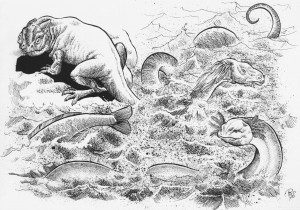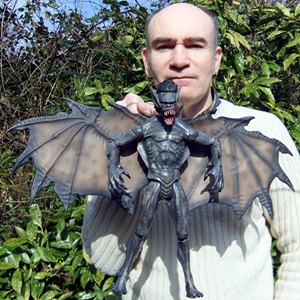Does the Loch Ness Monster Have a Split Personality?
Posted by: Karl Shuker on July 15th, 2013
Today, the classic, pre-eminent image indelibly engrained in everyone’s mind when speaking of Nessie, the Loch Ness monster (LNM), is that of a plesiosaur lookalike, complete with long slender neck and tail, small head, and four large diamond-shaped flippers. However, this was not always the case. In the past, a great diversity of alternative ideas concerning the likely appearance and identity of Scotland’s cryptozoological megastar existed.

Nowadays, however, most of these have been long forgotten. Yet they included some truly extraordinary notions and fascinating sightings, which richly deserve their belated resurrection here, as we examine just a selection of those most curious of LNM identities – identities that may have been, might still be, and surely could never, ever be…could they?
Further details can be found here, on my ShukerNature blog.
About Karl Shuker
My name is Dr Karl P.N. Shuker. I am a zoologist (BSc & PhD), media consultant, and the author of 25 books and hundreds of articles, specialising in cryptozoology and animal mythology. I have a BSc (Honours) degree in pure zoology from the University of Leeds (U.K.), and a PhD in zoology and comparative physiology from the University of Birmingham (U.K.).
I have acted jointly as consultant and major contributor to three multi-author volumes on cryptozoology and other mysterious phenomena.
I am the Life Sciences Consultant to The Guinness Book of Records/Guinness World Records (Guinness: London, 1997-present day), and was consultant to Monsters (Lorenz Books: London, 2001), as well as a contributor to Mysteries of the Deep (Llewellyn: St Paul, 1998), Guinness Amazing Future (Guinness: London, 1999), The Earth (Channel 4 Books: London, 2000), and Chambers Dictionary of the Unexplained (Chambers: London, 2007).
I appear regularly on television & radio, was a consultant for the Discovery TV series Into the Unknown, and a question setter for the BBC's quiz show Mastermind.
I am a Scientific Fellow of the Zoological Society of London, a Fellow of the Royal Entomological Society, a Member of the Society of Authors, and the Cryptozoology Consultant for the Centre for Fortean Zoology (CFZ).
I have written articles for numerous publications, including Fortean Times, The X Factor, Paranormal Magazine, FATE, Strange Magazine, Prediction, Beyond, Uri Geller's Encounters, Phenomena, Alien Encounters, Wild About Animals, All About Cats, All About Dogs, Cat World, etc.
In 2005, I was honoured by the naming of a new species of loriciferan invertebrate after me - Pliciloricus shukeri.










I think this is a great example of inherently deciding on what a cryptid is when you don’t know for sure. You decide all the evidence adds up to what you believe it is, and then everything you run across begins fitting that motif.
It happens with the scoftics all the time and it happens with skeptics too. It’s a natural pitfall of everyone in this arena–the minute you’re convinced it’s a specific type of creature (even though the creature has not been proven), you look at every piece of evidence with this idea in mind and mentally throw out anything that doesn’t fit, or alter the account to fit the theory.
I’m not judging here–I’ve done it too–just pointing out how the perceptions of Nessie have changed–as obviously stated in this article, and it has to do with Nessie champions deciding what it “probably” is and then looking for evidence to back it up.
This is a good case study for the newer cryptos . . .and the seasoned ones–to do a mental check when you’re looking into these things. You’ve got to keep yourself honest while you’re investigating–trying to keep an objective eye, even when you “know” what the answer is…until you uncover the truth.
It’s harder than it appears…
What my friend saw with her family up close was definitely Plesiosaur like.
I do not believe that the long-necked image is actually a valid representation of whatever Nessie is. The public became wedded with long-necked image due to the Wilson photograph which attained world -wide fame in very cropped form and now has at least some doubt cast upon it. Add to this the series the Searle photos and also those from Doc Shiels which show long-necked – if fraudulent -Nessies and the Rhines images, now know to have been enhanced by some magazine art editors to actually show something, I am hard pressed to accept any long-necked evidence/sightings as being reliable. I am starting to come to the conclusion that the very popular Plesiosaur image as an explanation for the sightings in Loch Ness is just that…a popular conception born of the images mentioned above. Before the hoaxing and innocent misidentifications, I don’t feel that there is any evidence of Nessie actually having a long neck and not just a series of humps or single hump. The surviving plesiosaur theory is not tenable as they became extinct 65 million years ago and weren’t in existence when the Loch was formed 10 thousand – read thousands – of years ago by glacial retreat. Also these air-breathing marine reptiles were surface dwelling animals and would be seen frequently going about their activities – that is if they could stand the very cold water temperature of the Loch which is quite far North in latitude and was formed during an Ice Age, not conducive to reptiles. Whatever Nessie is…is it not a plesiosaur as we know it.
Marcodufour–has anyone recorded/transcribed their account? If not, you might consider doing it yourself (ideally, with artistic renderings to illustrate what they saw–however crudely drawn).
I tend to go along with the end of your idea too–cryptokellie–“it’s not a plesiosaur as we know it.”
As to what Nessie is, I haven’t figured it out yet:) I read an article about two years back where they found fossils of plesiosaurs in what would have been a cold climate in the rock strata of the time, so according to that it would be possible for them to live in a cold climate. However, I have a ton of problems with the fossil record because: it’s really limited. We have a ton of fossils, yes, but it’s far from complete, and very hit and miss, so I’m not usually “keen” on using the fossil record as a point of proof or making a case against a particular critter.
The head and neck sightings are significantly less in the overall number of sightings for Nessie–the most often seen being the hump or the upturned boat. However, there have been some recognized accounts of Nessie extending a head and neck–the water Baliff, and a group of priests out fishing on the loch both saw a head and neck. I can’t remember off the top of my head what the Spicers saw on the road–but they only got a fleeting glimpse of something big moving across the road.
I don’t count the surgeon’s photo–not because it was a bonafide hoax–apparently the death bed confession may well have been a hoax too, but for me, that picture just never seemed to have the proper proportions for what I have gleaned from all of the other reports. The list of pictures taken over the years appear to contain a lot of faking and chicanery.
There was a 1938 video that was shot, and I got to see a few seconds of it on one of the older shows (maybe In Search Of), and supposedly they had a couple of minutes of footage, but I’ve never been able to find out any more about what happened to it, and if indeed there was more to it.
In any case, apparently even Charlie Sheen wasn’t enough to bring Nessie up–I’d say she could have had a rare sighting of her own, but I doubt Sheen was sober and I’m sure she’s seen enough of his usual nonsense on any tavern tele…
People have to understand that Loch Ness was created by the retreat of a glacier somewhere around 10 thousand years ago. That’s 10,000 years ago. The last of the plesiosaurs disappeared from the fossil record along with all the other marine reptiles (excluding sea turtles) around 65 million years ago. That’s 65,000,000 years ago. It is highly unlikely that plesiosaurs survived for 64,990,000 years somewhere to wind up in Loch Ness. Is it impossible – well – no, but the chances are more than 1 in 65 million that they didn’t. Yes, 64 million years is enough time for a species to evolve into something that might be able to survive in a body of water like the Loch…but then it would no longer be a plesiosaur.
chewbaccalacca – Part of the testimony by my friend`s sister was transcribed and put on a t.v. programme, my friend saw it at a later date, as for illustrating it, i don`t believe it was done, but another witness painted what they saw which again was very Plesiosaur like. They were 3 local lads that saw it from a height, as they were sitting on a hill overlooking the loch watching the sun come up, i think people need to get to the heights to see a more panoramic view and to be able to see details clearly.
cryptokellie – these animals have been seen in the sea and in sea lochs too.
Marcodufour;
I answered this same response in the “Lake Monsters; Where Are The Bodies” post.